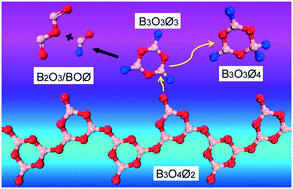Structural studies of a Li2O·4B2O3 melt by high-temperature Raman spectroscopy and density functional theory†
Abstract
LiB3O5 crystals are often grown from the Li2O·4B2O3 high-temperature melt. Information about the melt structure is essential for interpreting the macro-properties of the melt and investigating the micro-process of LiB3O5 crystal growth, but it still remains unknown. In this work, a method combining Raman spectroscopy and density functional theory (DFT) was employed to determine the Li2O·4B2O3 melt structure. The results show that B3O4Ø2 (Ø = bridging oxygen) and B3O3Ø3 rings are the main species present in this melt. A small number of BØ4 units and B![[double bond, length as m-dash]](https://www.rsc.org/images/entities/char_e001.gif) O double bonds were also found in the Li2O·4B2O3 melt. The BØ4 units are formed via the connection of the non-bridging oxygen atoms in the B3O4Ø2 rings to the boron atoms in the neighbouring B3O3Ø3 rings; the B
O double bonds were also found in the Li2O·4B2O3 melt. The BØ4 units are formed via the connection of the non-bridging oxygen atoms in the B3O4Ø2 rings to the boron atoms in the neighbouring B3O3Ø3 rings; the B![[double bond, length as m-dash]](https://www.rsc.org/images/entities/char_e001.gif) O bonds are formed by the breakage of the B3O3Ø3 rings. The structure has been used to interpret the high viscosity and the viscosity anomaly phenomenon of the Li2O·4B2O3 melt and to understand the micro-process of LiB3O5 crystal growth.
O bonds are formed by the breakage of the B3O3Ø3 rings. The structure has been used to interpret the high viscosity and the viscosity anomaly phenomenon of the Li2O·4B2O3 melt and to understand the micro-process of LiB3O5 crystal growth.



 Please wait while we load your content...
Please wait while we load your content...